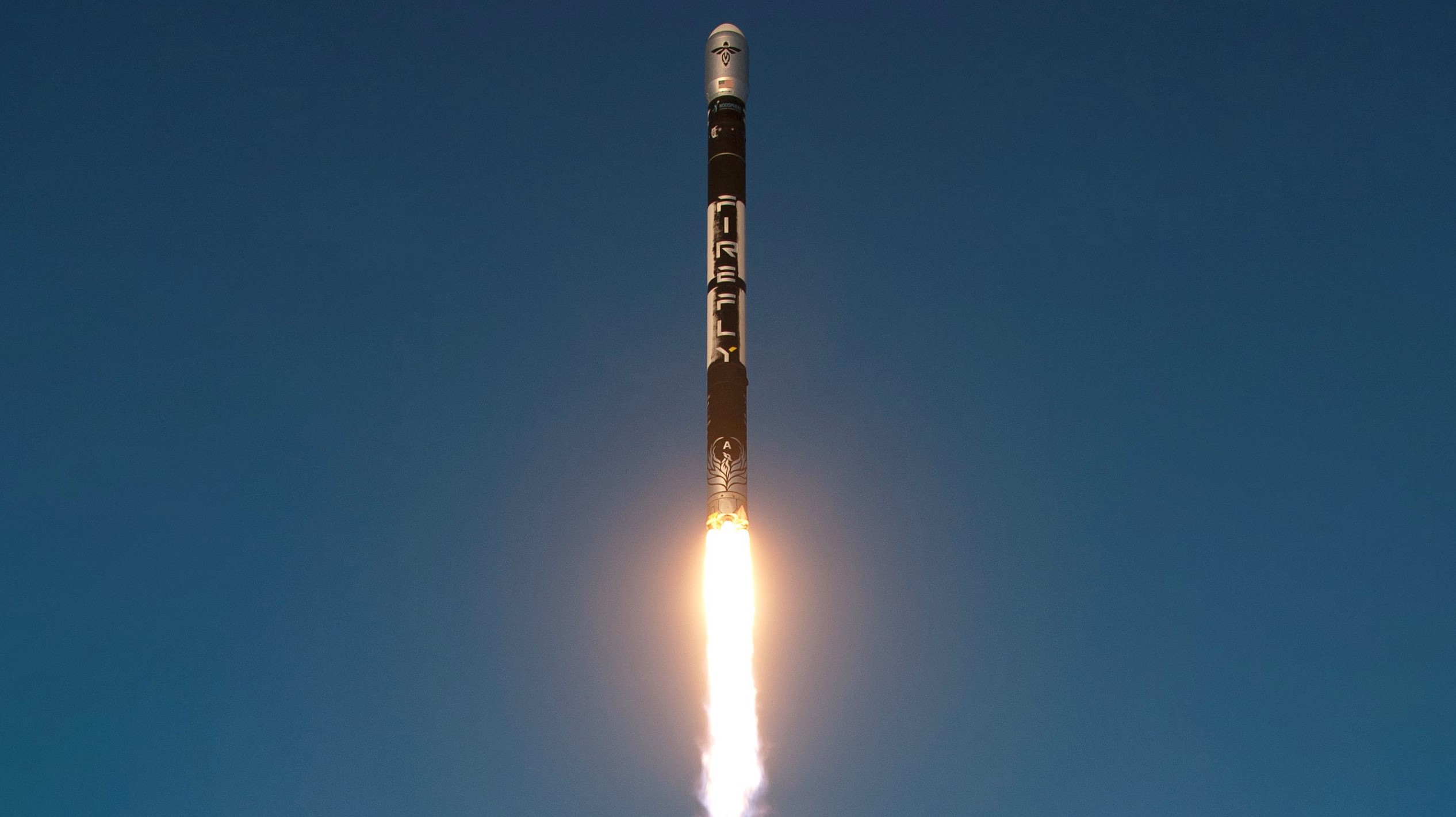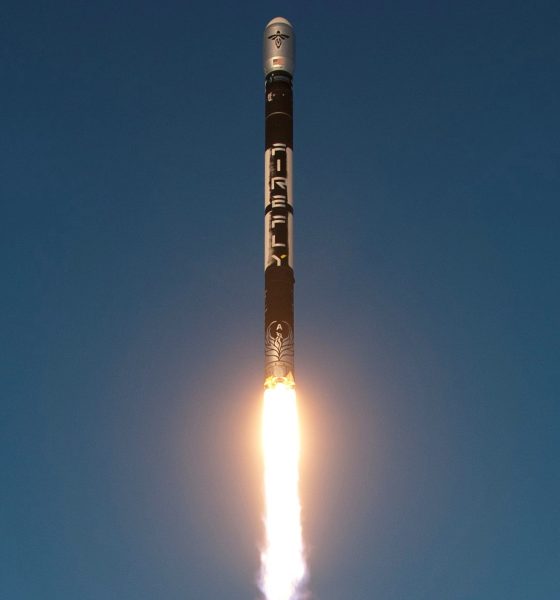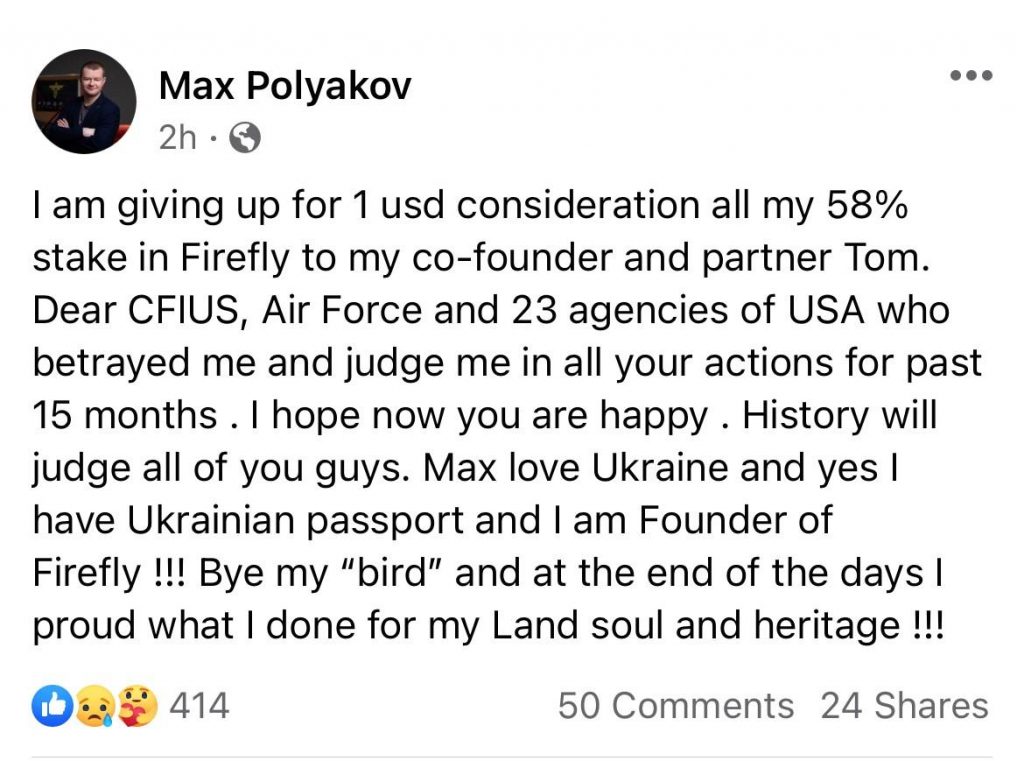

News
Firefly nears second orbital launch attempt as US forces Ukrainian founder to divest
While the rocket startup he is responsible for resurrecting is preparing for a second orbital launch attempt, a Ukrainian multimillionaire – an entrepreneur, businessman, and the founder of Firefly Aerospace – has once again been forced to take extreme actions by the US government.
Resurrected in 2017 after going bankrupt and ceasing operations the year prior, Firefly is a private launch provider based out of Austin, Texas and founded by Maxim Polyakov and former CEO Tom Markusic. Polyakov has supported the company since its second inception, privately funding the startup with over $200 million earned through success in Ukrainian tech industries. With those contributions, Polyakov was able to singlehandedly resurrect the startup from bankruptcy and continue the development of an even more ambitious Alpha launch vehicle.
For the last two years, though, Polyakov has been under scrutiny from US government officials, who’ve objected to Polyakov – a Ukrainian and UK citizen – having control over the company, with fears that the launch technology developed by the company could make its way back to Ukraine and poses a national security threat.
The update that's rolling out to the fleet makes full use of the front and rear steering travel to minimize turning circle. In this case a reduction of 1.6 feet just over the air— Wes (@wmorrill3) April 16, 2024
In late 2020, Polyakov quietly stepped down as chairman and withdrew from Firefly’s day-to-day operations in the hopes of killing the controversy and giving the startup a better chance at being awarded government contracts. Firefly’s board of directors includes many former U.S government officials, including Deborah Lee James, former secretary of the Air Force, and Robert Cardillo, former director of the National Geospatial Intelligence Agency.
However, officials were not satisfied with Polyakov simply stepping down from operations, indicating they want him to have less ownership in the company as well. In November 2021, just two months after Firefly’s inaugural flight test, Polyakov received a letter from the Committee on Foreign Investment in the U.S (CFIUS). This letter expressed these ongoing concerns and asked that he, along with his investment company, Noosphere Venture Partners, sell their stock in Firefly; which amounted to over 50% stake in the company. Because of this request, Firefly halted their operations at Vandenberg Air-force Base.
Before halting launch operations, Firefly claimed to be on track for another Alpha launch as early as January 2022. Firefly’s first launch on September 2nd, 2021 ended in failure around two minutes after liftoff due to a premature engine shutdown. Jason Mello, president of Firefly Space Transportation Services, stated in an interview that fixing the problem responsible for the failure was “fairly easy and straightforward.”
On February 16th, 2022 Polyakov revealed that the United States government had once again gone on the offensive, this time forcing him to fully and permanently cede any involvement in his company. He posted the following statement on Facebook:

Polyakov revealed that he chose to sell his 58% stake in the company to co-founder and CEO Tom Markusic for $1 USD – a selfless act given that selling his stake for nothing all but guarantees he will never recoup a cent of the several hundred million dollars he invested in Firefly.
Previously, Polyakov expressed how excited he was to turn Firefly into a massive aerospace company that both the United States and Ukraine could be proud of and benefit from. “During the Soviet era, Ukraine produced some of the world’s best rocket and engine technology, but much of those inventions have languished in recent years due to lack of investment. The hope was that Firefly could pair its best engineers from the U.S. and Ukraine together to make a fleet of large rockets capable of taking many satellites into orbit and, later on, missions to the moon. Polyakov wanted the U.S. to gain access to Ukrainian expertise, while also finding a way to boost the prospects of Ukrainian aerospace engineers, he has said.” (Bloomberg)
It is speculated that the US government’s sudden and extreme requests came because of concerns over the rising tensions caused by Russia’s increasingly unstable posturing and recurring threats of invasion. Even though Ukraine is friendly with the United States, concerns of conflict with Russia may have increased worries about what might happen to technology developed inside of the country. Ukraine, a sovereign nation, has been forced to increase security along its borders as fear of a Russian invasion grows.
Despite the recent legal and organizational setbacks and drama caused by the US government, Firefly has been doing extremely well from a technical standpoint. The company recently shared a video of the successful static fire testing of both stages of the second Alpha rocket, indicating that it could be ready for flight in the very near future. Even though Polyakov was forced to abandon his aerospace startup, it’s never been more clear that his investment not only saved Firefly but raised the company closer to success than it’s ever been before.

Elon Musk
Elon Musk just said some crazy stuff about the Tesla Roadster

Elon Musk appeared on the Moonshots podcast with Peter Diamandis today to discuss AGI, U.S. vs. China, Tesla, and some other interesting topics, but there was some discussion about the upcoming unveiling of the Roadster, the company’s electric supercar that will arrive several years after it was initially slated for release.
Musk made some pretty amazing claims about the Roadster; we already know it is supposed to be lightning-fast and could even hover, if Tesla gets everything to happen the way it wants to. However, the car has some pretty crazy capabilities, some of which have not even been revealed.
On the podcast, Musk said:
“This is not a…safety is not the main goal. If you buy a Ferrari, safety is not the number one goal. I say, if safety is your number one goal, do not buy the Roadster…We’ll aspire not to kill anyone in this car. It’ll be the best of the last of the human-driven cars. The best of the last.”
🚨 Elon on the Roadster unveiling, scheduled for April 1:
— TESLARATI (@Teslarati) January 6, 2026
Musk makes a good point: people who buy expensive sports cars with ridiculous top speeds and acceleration rates do not buy them to be safe. They hope they are safe in case of an emergency or crash, but safety is not at the forefront of their thoughts, because nobody buys a car thinking they’ll crash it.
The Roadster is truly going to push the limits and capabilities of passenger vehicles; there’s no doubt about that. Tesla plans to show off the new version car for the first time on April 1, and Musk has only hinted at what is possible with it.
Musk said back in November:
“Whether it’s good or bad, it will be unforgettable. My friend Peter Thiel once reflected that the future was supposed to have flying cars, but we don’t have flying cars. I think if Peter wants a flying car, he should be able to buy one…I think it has a shot at being the most memorable product unveiling ever. [It will be unveiled] hopefully before the end of the year. You know, we need to make sure that it works. This is some crazy technology in this car. Let’s just put it this way: if you took all the James Bond cars and combined them, it’s crazier than that.”
Production is set to begin between 12 and 18 months after the unveiling, which would put the car out sometime in 2027. Hopefully, Tesla is able to stay on track with the scheduling of the Roadster; many people have been waiting a long time for it.
News
Tesla launches hiring for Robotaxi program in its twentieth country
Overall, the hiring signals Tesla’s aggressive timeline for global dominance in autonomous mobility.

Tesla has launched a hiring initiative for its Robotaxi program in its twentieth country, as the company posted two new jobs in Thailand this week.
Tesla is hiring in Bangkok and Kowloon for the Vehicle Operator position, which is related to data collection, and is the first in Thailand, but the twentieth country overall, as the company tries to expand into other markets.
🚨 BREAKING: Tesla is hiring additional full-time Vehicle Operators in Bangkok, Thailand.
Previous openings were 6-month, part-time roles. These are equivalent to AI Safety Operator roles in the U.S. pic.twitter.com/R6LzoU1bos— Tesla Yoda (@teslayoda) January 5, 2026
Tesla has had active job postings for Vehicle Operator positions in the United States, India, Israel, Taiwan, Germany, the Czech Republic, Hungary, the UK, Finland, Switzerland, Sweden, the Netherlands, Austria, Spain, Norway, Italy, and Turkey in past listings.
These postings are not all currently available, likely because the roles have been filled.
Thailand is the most recent, and broadens the company’s potential path to expanding its ride-hailing program, which is only active in the United States in Austin, Texas, and the California Bay Area, so far.
These roles typically involve data collection, which assists in improving Autopilot and Full Self-Driving operation. Tesla’s self-driving programs utilize real-world data that is accumulated and stored, observing vehicle and traffic behavior, as well as tendencies that are performed by human drivers to help increase safety and overall performance.
Overall, the hiring signals Tesla’s aggressive timeline for global dominance in autonomous mobility. Although the company has several high-profile rivals and competitors in the field, it has established itself as a main player and a leader in the development of autonomous technology, especially in the U.S., as its FSD suite is refined on almost a weekly basis.
The Full Self-Driving suite is available in seven countries and territories currently, including the U.S., Canada, China, Mexico, Puerto Rico, Australia, and New Zealand. Its biggest goal for expansion is currently the European market, where regulatory hurdles have been the main bottleneck prolonging its launch on the continent.
Tesla has performed months of testing in various European countries, including France and Spain, and does have support in some areas from various regulatory agencies. However, the company is hoping to get through this red tape and offer its suite in Europe for the first time, hopefully this year.
News
Tesla China rolls out Model Y upgrades, launches low-interest financing
These strategies are aimed at improving the ownership experience and keeping vehicle pricing competitive in the world’s largest electric vehicle market.

Tesla has rolled out minor updates to the five-seat Model Y in China, upgrading the vehicle’s center display to a higher-resolution 16-inch 2K screen. The electric vehicle maker also introduced attractive financing options, including 7-year low-interest rates, to offset the new purchase tax on EVs.
These strategies are aimed at improving the ownership experience and keeping vehicle pricing competitive in the world’s largest electric vehicle market.
Five-seat Model Y gets larger, better display
With its recent update, all three variants of the five-seat Model Y now feature an upgraded 16-inch 2K resolution center display, which replaces the vehicle’s previous 15.4-inch 1080p panel. This screen was already used in the six-seat Model Y L, and it offered improved visual clarity. Tesla China has also updated the Model Y’s headliner to black, giving the vehicle a sleeker appearance.
Prices of the five-seat Model Y remain unchanged at RMB 263,500, RMB 288,500, and RMB 313,500 for the respective trims. This update enhances the cabin experience as domestic rivals are already adopting high-resolution screens. As noted in a CNEV Post report, some domestic automakers have begun rolling out vehicles equipped with 3K-resolution displays.
New financing offers
Tesla also launched ultra-long-term financing offers for its locally produced models in China, which include the Model 3 sedan, the five-seat Model Y, and the six-seat Model Y L, through January 31, 2026. The 7-year option features an annualized fee rate as low as 0.5%, which is equivalent to 0.98% interest. This is expected to save customers up to RMB 33,479 ($4,790) compared to standard rates.
A 5-year zero-interest plan is also available, and it has been extended to the Tesla Model Y L for the first time. These incentives help offset China’s new 5% purchase tax on New Energy Vehicles (NEVs) in 2026-2027. Some of Tesla’s rivals in China have announced in recent months that they would be covering the purchase tax owed by buyers early this year.








